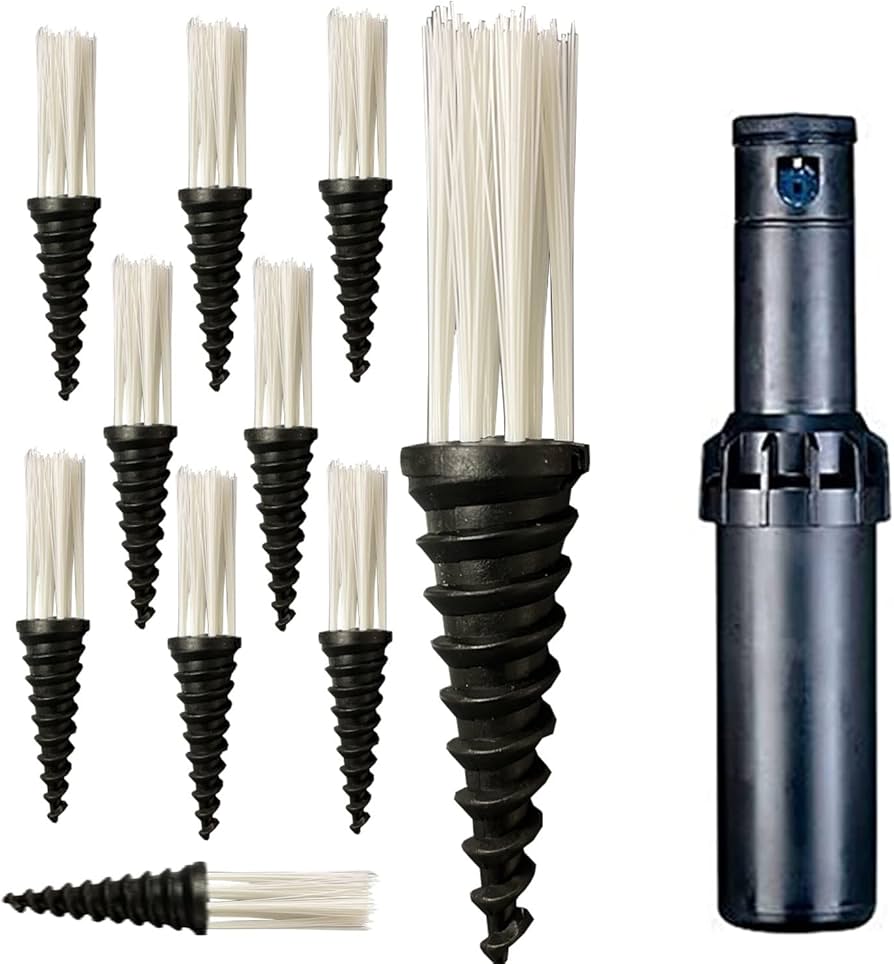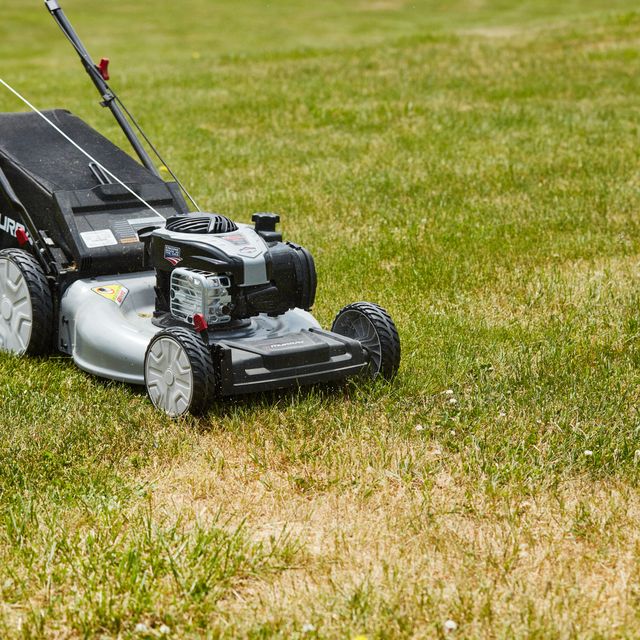Mowing over sprinkler heads can damage both the sprinklers and your mower. It’s best to ensure they’re properly retracted or protected before mowing.
Maintaining a lush, green lawn involves a careful dance between watering and cutting the grass. Your irrigation system, particularly sprinkler heads, plays a vital role in this process. They must be strategically placed and functional to ensure uniform water distribution.
Similarly, regular mowing is crucial for healthy turf, but comes with the potential risk of colliding with sprinkler hardware. Homeowners need to take precautions when managing their lawns to avoid costly repairs to sprinkler systems or damage to their mowers. This includes checking for sprinkler heads before each mowing session and investing in quality sprinkler head guards if necessary. Balancing the demands of proper irrigation and mowing practices will keep your garden in peak condition throughout the growing season.

Credit: www.amazon.com
Understanding Sprinkler System Components
Maintaining a lush green lawn calls for more than just periodic watering; it demands an understanding of the intricate workings of your sprinkler system. This includes recognizing how each segment operates from the valves to the sprinkler heads. A critical aspect to consider is whether common lawn maintenance tasks, such as mowing, can coexist with your sprinkler installation without causing damage. Let’s dive into the various segments and their roles in keeping your garden verdant.
In-ground Sprinkler System Overview
An in-ground sprinkler system is a network designed to distribute water evenly across your lawn with minimal effort. The constellation of components includes:
- Controller: Manages the watering schedule.
- Valves: Regulate water flow to different zones.
- Pipes: Transport water to the sprinkler heads.
- Sprinkler Heads: Disperse water across the lawn.
An in-ground system ensures sprinkler heads are flush with the ground, supposedly allowing mowing over them safely. However, accurate placement and quality equipment are crucial for this compatibility.
Importance Of Regular Maintenance
Periodic upkeep is non-negotiable for the longevity of a sprinkler system. Focused attention on routine maintenance comprises:
- Inspecting sprinkler heads for debris and malfunctions.
- Cleaning filters to ensure unimpeded water flow.
- Adjusting heads for optimal spray patterns and coverage.
- Checking for leaks that could undermine system efficiency.
Proactive care minimizes the risk of dysfunctional sprinkler heads, which can protrude above ground, posing hazards not only to your lawnmower blades but also to your lawn’s health. With ensured regular maintenance, mowing over sprinkler heads becomes a concern of the past, promoting a harmonious relationship between your sprinkler system and lawn care routine.
Potential Risks Of Mowing Over Sprinkler Heads
Keeping your lawn pristine often involves a delicate balance between regular mowing and efficient watering. With sprinkler heads dotting the landscape, a common question arises: “Can you mow over sprinkler heads?” While most modern sprinkler heads are designed to withstand a certain level of wear and tear, mowing over them without proper caution can lead to various unwanted scenarios. This section delves into the potential risks associated with this seemingly innocent practice.
Damage To The Sprinkler Heads
The foremost risk of mowing over sprinkler heads lies in the physical damage to these irrigation components. Sprinkler heads are generally built to be durable, but they are not invincible. Lawnmowers, with their powerful blades, can:
- Break or crack the sprinkler heads, especially if they are not retracted fully.
- Dislodge them from their proper position, affecting the watering pattern.
- Shear off the tops, rendering them useless and requiring replacement.
When a sprinkler head sustains damage, it invariably leads to additional costs for repairs or replacements, as well as the hassle of rectifying the sprinkler system back to its optimal condition.
Impact On The System’s Effectiveness
Beyond the physical harm to the individual components, mowing over sprinkler heads can also compromise the overall effectiveness of the irrigation system. Issues that may surface include:
| Impact on Effectiveness | Resulting Concern |
|---|---|
| Reduced Water Distribution | Uneven lawn hydration leading to dry patches or overwatered areas. |
| Altered Pressure | Insufficient watering pressure, affecting the reach and efficiency. |
| Leaks and Blockages | Wasted water and potential for extensive landscape damage. |
Ultimately, these issues can result in higher water bills, reduced lifespan of the irrigation system, and a lawn that does not meet your landscaping goals. To ensure the longevity and proper functioning of your sprinkler system, steer clear of mowing directly over the heads.
Best Practices For Mowing Near Sprinkler Heads
Ensuring the longevity of your sprinkler system while maintaining a lush lawn requires a delicate touch, especially when it comes to mowing near sprinkler heads. Proper techniques can prevent damage to both your mower and sprinklers. This section will guide you through the best practices for mowing near sprinkler heads, maintaining impeccable landscaping without compromising your irrigation system.
Height Adjustments For Lawnmower Blades
One key aspect of avoiding sprinkler head damage is adjusting the height of your lawnmower blades. A height that’s too low not only scalps the lawn, stressing the grass, but also increases the risk of clipping sprinkler heads. Aim for a mower setting that cuts grass at the recommended height for your turf type, generally around 3 inches for cool-season grasses and 2-2.5 inches for warm-season grasses. This not only promotes a healthy lawn but also keeps blades well above ground-level sprinkler heads. Use the mower’s manual to adjust blade height properly before each mowing session, especially if you recently aerated or you have uneven ground.
Maintaining A Safe Distance From Sprinkler Heads
- Visual Inspection: Before mowing, walk around the lawn and make note of where each sprinkler head is located. If they’re not retractable, consider using temporary markers as a visual reminder.
- Mowing Pattern: Start mowing in a pattern that moves away from the sprinkler heads. This approach helps to avoid direct contact as the mower moves forward.
- Use Trimmers: For the grass immediately surrounding the sprinkler heads, a hand trimmer provides better control and precision. Trim carefully to prevent accidental snags.
- Sprinkler Guards: Installing sprinkler head guards or donuts can provide an extra layer of protection, creating a buffer between the blade and the sprinkler. Always ensure these are properly installed and sit flush with the soil to maintain mower clearance.
Implement these strategies with diligence to safeguard the essential components of your irrigation system. Proper mowing techniques extend beyond mere aesthetics; they form the bedrock of effective lawn care and maintenance.
Precautionary Measures To Safeguard Sprinkler Heads
As a homeowner with a lawn to boast about, your sprinkler system is the veins of your greenery’s life source. Protecting your sprinkler heads is not just about saving money on repairs; it’s about ensuring your luscious lawn receives the hydration it needs, without interruption. Regular lawn maintenance includes mowing, but one wrong move and you could end up damaging the sprinkler heads. Before you fire up that mower, let’s dive into essential measures that shield your irrigation essentials.
- Create a detailed map of your lawn and mark the exact locations of all sprinkler heads. Use a grid layout or a clear sketch. Keep this map handy for quick reference before mowing.
- Use visible markers to highlight sprinkler head positions. These can be flags, stakes, or any distinct, temporary object placed beside the sprinkler heads on mowing day.
- Walk the lawn pre-mowing to visually spot all sprinkler heads. This serves as a physical reminder of the areas to avoid when operating the lawnmower.
Sprinkler guards or shields act as a physical barrier between the mower’s blades and the sprinkler heads, deterring potential collisions. A protective shell doesn’t just stop at keeping mowers at bay; it’s also a defense against playful pets and foot traffic.
- Choose the right type of guard for your sprinkler heads. There are various designs, from simple donut-style to more elaborate guards, tailored to the shape and size of your sprinklers.
- Install the guards securely so they don’t displace during lawn mowing or under pressure from garden activity.
- Regularly inspect and maintain these guards for cracks or dislodgement, ensuring they remain effective in protecting your sprinkler heads.
Maintaining A Healthy Lawn And Sprinkler System
A lush, green lawn is the crowning glory of many gardens, but achieving it can be a delicate balancing act. The secret to success lies in the harmonious relationship between your lawn and its irrigation system. Mowing and watering practices need to mesh seamlessly to ensure the health of your grass and the longevity of your sprinkler heads.
Proper Watering And Maintenance Routine
Establishing a consistent watering routine is crucial for a vibrant lawn. Grass requires a steady supply of water, particularly during dry spells, to maintain its vigor and resilience. Your sprinklers need to distribute water evenly and at the right times to minimize waste and maximize benefit. Optimal watering occurs during the early morning, when temperatures are cooler, and evaporation is minimized.
- Check sprinkler placement to cover all areas of your lawn without overspray onto sidewalks or driveways.
- Adjust the timing and frequency of your sprinklers according to weather conditions and season.
- Mow your grass to the recommended height for your specific turf species. Taller grass promotes deeper root growth and retains soil moisture better.
Additionally, ensure your irrigation system is maintained properly. This involves cleaning filters, checking for leaks, and making sure the system is free of any obstructions. Remember, a well-maintained system saves water and reduces costs over time.
Regular Inspection And Repairs For Sprinkler Heads
Regular inspections of your sprinkler heads are crucial to avoid costly replacements and ensure they are functioning correctly. Sprinkler heads can become damaged due to lawn equipment, foot traffic, or natural wear and tear over time. Immediate repair or replacement of damaged sprinkler heads ensures optimal performance and prevents water waste.
- Inspect your sprinkler heads monthly for clogs, leaks, or misalignment.
- Clean or replace any nozzles that are obstructed with debris to maintain even water distribution.
- Check for and repair any signs of damage, such as cracked casing or heads that don’t retract after watering.
Practicing these maintenance steps helps prevent accidents with your lawn mower. Mowing over sprinkler heads can cause significant damage to both the sprinkler system and the mower, leading to unnecessary expenses. Ensure that sprinkler heads sit flush with the ground and are clearly visible, to avoid them being struck during mowing.
Frequently Asked Questions Of Can You Mow Over Sprinkler Heads
Can Mowing Damage Sprinkler Heads?
Mowing over sprinkler heads can cause damage if they’re not properly retracted. Ensure sprinkler heads are flush with the lawn surface and retract fully after watering to prevent mower blades from striking them. Regular maintenance checks can mitigate potential harm to your irrigation system.
How To Protect Sprinkler Heads While Mowing?
To protect sprinkler heads, use concrete donuts or protective covers. These provide a barrier between the mower and the sprinkler heads. Additionally, keeping grass around the sprinklers trimmed can increase visibility, helping to avoid accidental collisions during lawn mowing.
What Height Should Sprinkler Heads Be?
Sprinkler heads should be installed so their tops are level with the soil surface. This allows the heads to pop up and retract without obstruction from the soil or grass, minimizing the risk of being hit or damaged by a lawn mower.
Is It Safe To Mow Over Hidden Sprinkler Heads?
Mowing over hidden sprinkler heads is risky and can lead to damage. Ensure that all sprinkler heads are visible and properly retracted before mowing. If you suspect that a sprinkler head may be covered, locate and expose it to prevent mower blades from causing damage.
Conclusion
Mowing over sprinkler heads is risky. It can cause costly damage to your irrigation system. For safe lawn maintenance, ensure sprinkler heads are retracted or protected. Regularly inspect and maintain both equipment to avoid mishaps. Embrace caution and enjoy a pristine, well-hydrated landscape.
